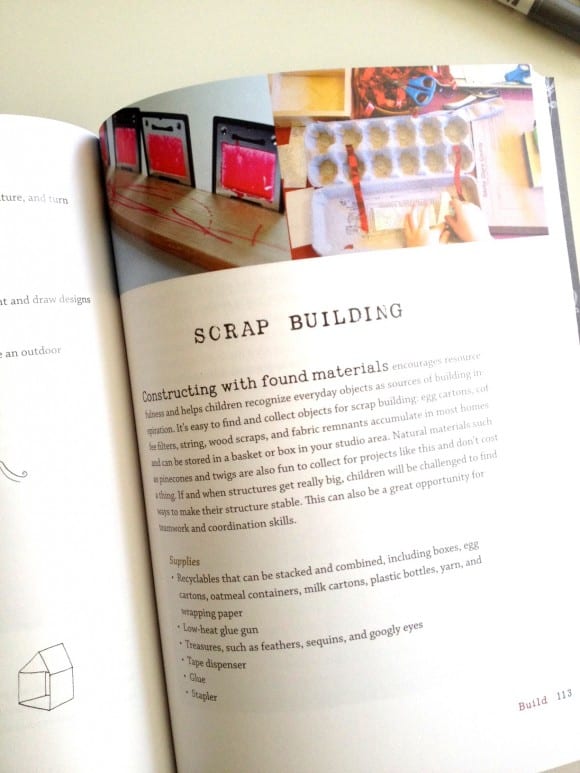My dear friend, Rachelle Doorley, the creative mind behind the kids’ activity blog, TinkerLab, wrote a book that touches me deeply. We are all trying to raise children who can thrive in an uncertain world, but the big question is, “How do we do it?”
Rachelle’s beautiful hands-on book gives children opportunities to think for themselves, problem-solve, innovate, and most importantly, believe they are all little creators. I think she’s onto something…
I asked Rachelle a few questions about her book:
What inspired you to start TinkerLab and did you ever think it would become a book some day?
I started TinkerLab when my older daughter was almost two-years old. She and I spent countless hours squashing play dough, inventing play worlds in our garden, and experimenting with kitchen supplies. It was such a fun time for us, and I realized that I wanted to write a book about fostering creativity in this early part of childhood however, when I made this realization, I was also in the trenches of parenting a small child and it was impossible to wrap my head around the extensive task of writing an entire book. The idea of starting a blog seemed far more tangible!
I found a URL, signed up for a host, and wrote my first post within the week… simple as that! Writing this book is a dream come true, and I’m so happy to hear that it’s transforming so many lives.
If you had one message or take-away for busy parents trying to add more creativity into their children’s lives, what would it be?
Take heart that you don’t need to fabricate elaborate, picture-perfect projects in order to add more creativity into your family’s life. Because creativity comes from imagination and a desire to problem solve, children will be far more creative if they can be in charge of their ideas.
One of my favorite strategies that fosters this internal motivation is to set up a self-serve maker zone. This could be a designated art table or a corner of your kitchen table. Within this area, have buckets of easy-access materials such as markers, glue, and crayons, a ream of paper, scissors, and play dough that your child can find when an idea strikes. While you might need to take some time to show a young child how to use scissors properly, or lay some ground rules for using glue, once the area is set up, you’ll find that your child will create with very little prompting from an adult.
What is your favorite experiment/project from the book?
This is a hard one since I love them all!! The Scrap Building project (page 113) has been my go-to project for the hands-on activity that I present on the TinkerLab book tour, and it’s been really successful with children of all ages.

In a nutshell, gather clean recyclables, odd and ends, and treasures such as sequins and pom poms, and present them to your child along with a low-heat glue gun. Low-heat glue guns are the best, and I’ve seen preschoolers use them quite effectively!
Offer these materials to children along with some googly eyes, and the invitation to create a critter. Children love this challenge! The fun in it for me, is to see how differently each child interprets the materials — one child makes eyes out of sequins, another deconstructs a pom pom and turns it into a teddy bear, and another turns a piece of scrap wood into Hans Solo from Star Wars. The possibilities are endless.
The last time I ran this project, the children turned their critters into an imaginative game and used them like action figures. Not only did they have fun inventing their own critters, but they went on to use them as toys. So cool!
Lainey, my daughter, is in love with the book, and can’t stop looking at the photos. Here are the projects she wants to try:
And for me, this is my favorite page: “Ten TinkerLab Habits of Mind.” Since creativity is all about being mindful, stepping back and enjoying the flow, seeing mistakes as gifts, and embracing a good mess, what a great reminder this page is. Thanks, Rachelle. I needed that today. 🙂
If you are a parent, I promise this book will speak you, too. And if you want to give an extra special baby shower gift to a new mom, just bundle it with a few basic art supplies and you’ve got a gift that will keep on giving for years to come.
Here’s where you can buy it. Enjoy! And thanks, Rachelle, for writing a book that makes us all better parents, and our children, better thinkers and innovators.
[iframe http://ws-na.amazon-adsystem.com/widgets/q?ServiceVersion=20070822&OneJS=1&Operation=GetAdHtml&MarketPlace=US&source=ac&ref=qf_sp_asin_til&ad_type=product_link&tracking_id=camypa-20&marketplace=amazon®ion=US&placement=161180065X&asins=161180065X&linkId=PN526DHVWZDHZXFE&show_border=true&link_opens_in_new_window=true 120 240]




